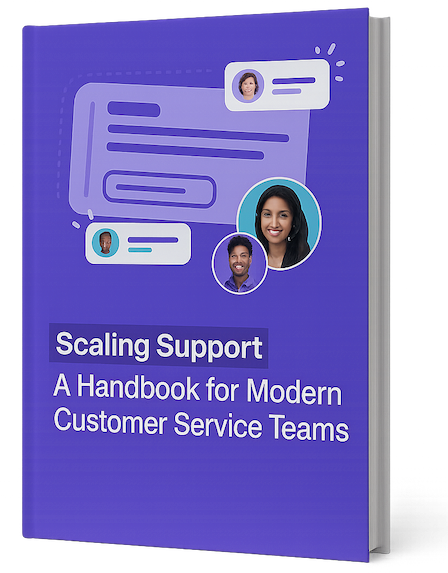Understanding What Really Drives Customer Satisfaction

Getting to the heart of customer satisfaction requires looking deeper than basic metrics. While strong Customer Satisfaction (CSAT) scores are valuable, they only tell part of the story. To build real satisfaction and loyalty, companies need to understand what motivates customers on a fundamental level. This means examining the key elements that create consistently positive experiences.
Beyond the Numbers: The Psychology of Satisfaction
Think about what makes a restaurant visit memorable – it's rarely just getting the right food at the right time. The friendly server who remembers your preferences, the unexpected complimentary appetizer, or the personal touch that makes you feel valued – these emotional connections transform a basic transaction into a delightful experience. This highlights an essential truth: customer satisfaction comes from building relationships, not just meeting basic expectations. By understanding each customer's unique needs, preferences and pain points, companies can create interactions that resonate on a personal level.
Measuring What Matters: Key Metrics for Customer Satisfaction
While CSAT provides useful snapshots of satisfaction at specific moments, other metrics help paint a fuller picture of long-term customer relationships. For instance, Net Promoter Score (NPS) measures how likely customers are to recommend your business to others – a key indicator of loyalty and organic growth. The Customer Effort Score (CES) evaluates how easy it is for customers to get what they need, with lower scores indicating smoother experiences that boost retention. For example, simplifying website navigation or providing better self-service options can significantly reduce friction points. Together, these metrics offer a comprehensive view of the customer journey, revealing both strengths and opportunities.
From Insights to Action: Driving Real Change
Data collection is just the beginning. The true value comes from translating insights into concrete improvements. This requires carefully analyzing customer feedback, identifying patterns, and implementing targeted solutions. For instance, if customers consistently report long support wait times, adding live chat or expanding self-service resources can dramatically improve their experience. Success also depends on building a culture where every employee focuses on customer needs. When teams are empowered to solve problems efficiently and share feedback openly, it creates an ongoing cycle of learning and improvement. This approach turns customer satisfaction from a metric into a genuine competitive edge that drives growth and profitability.
Building a Culture That Lives and Breathes Customer Success
Every successful customer service organization puts customers first – not just in words, but in actions that demonstrate genuine care. When customer satisfaction becomes a core value rather than just another metric, it drives real growth by creating loyal customers who keep coming back. Making this shift requires focusing on three key elements: empowering employees, aligning incentives, and creating feedback loops.
Empowering Your Employees To Champion Customer Needs
Your frontline employees interact with customers daily and have a huge impact on satisfaction levels. When you give them the tools, training and autonomy to resolve issues creatively, they become true customer advocates. For example, equipping support teams with detailed knowledge bases and decision-making authority helps them solve problems quickly without endless escalations. It's like dining at a restaurant – would you rather have a server who needs manager approval for every small request, or one who can handle reasonable issues immediately? The latter creates a much smoother experience.
Open feedback channels are also vital. When employees feel heard and see their suggestions implemented, they stay engaged and motivated to help customers succeed. Regular check-ins and surveys identify pain points that need fixing and opportunities to make things better for customers.
Aligning Incentives With Customer-Centric Goals
Building customer focus requires incentives that reward great service at every level. Rather than just tracking satisfaction scores, recognize employees who consistently go above and beyond, solve tricky problems creatively, and make customers happy. For instance, featuring success stories in company newsletters and team meetings reinforces these behaviors and inspires others.
Leadership must also demonstrate commitment through actions. When executives regularly review customer feedback and use those insights to guide strategy, it sends a clear message that customer satisfaction matters. Research shows that companies whose leaders actively champion customer experience have higher employee engagement and satisfaction scores.
Fostering Continuous Feedback and Improvement
Sustaining customer success requires constant feedback and refinement. Regular input from both customers and employees reveals what's working and what needs work. Having systems to collect and analyze this feedback helps spot trends and fix issues systematically. Use tools like surveys and social listening to understand the full customer journey. Then act on that feedback by making targeted improvements and measuring results. For example, if customers consistently mention long wait times, adding chat support or self-service resources can dramatically improve their experience.
This ongoing cycle of listening and adapting ensures you keep meeting changing customer needs. But more importantly, it shows customers you truly care about their success.
Creating Feedback Systems That Drive Real Change

Getting customer feedback is one thing, but using those insights to make meaningful improvements is where many companies struggle. The most successful organizations have figured out how to turn customer input into better experiences. In fact, companies that focus on customer experience have seen revenue increases of 4-8% – showing just how much impact these efforts can have.
Designing Effective Feedback Mechanisms
To drive real change, you need feedback systems that make it easy for customers to share their thoughts and give you actionable data. This means creating clear, focused surveys that ask about specific aspects of the customer experience. Give customers multiple ways to provide input – whether through online forms, email surveys, or social media channels. Having these different options helps capture diverse perspectives and builds a complete picture of customer satisfaction.
Analyzing Feedback For Actionable Insights
Once you have customer feedback, the key is analyzing it effectively to spot trends and areas for improvement. For instance, if multiple customers mention having trouble navigating your website, that's a clear signal something needs to change. But finding issues is just the start – you need to turn those insights into concrete steps. This could mean redesigning navigation menus, making product information clearer, or improving your customer support processes.
Implementing Change and Measuring the Impact
Making changes based on feedback is an ongoing cycle of improvement. You need to track whether those changes actually make things better for customers. Monitor key metrics like CSAT, NPS and CES scores before and after implementing changes to measure their impact. For example, if you update your customer onboarding process, look at whether satisfaction scores improve afterwards. This data-driven approach helps ensure you're making the right changes. Just as importantly, showing customers that you take their feedback seriously and act on it helps build lasting relationships. When customers see you making improvements based on their input, it increases their trust and loyalty over time.
Eliminating Pain Points in the Customer Journey
Customer satisfaction depends heavily on smoothly guiding customers through each interaction with your business. When customers hit snags or barriers, their experience suffers. By systematically finding and fixing these pain points across the entire customer journey, companies can build stronger loyalty and keep more customers coming back.
Mapping the Customer Journey for Enhanced Satisfaction
To eliminate pain points effectively, you first need a clear picture of how customers engage with your brand. Map out each touchpoint – from discovering you on social media, to browsing your website, joining your mailing list, making purchases, and reaching out for support. Each interaction shapes their experience.
Looking at this journey end-to-end helps spot trouble areas. For example, if customers regularly abandon their shopping carts, that signals friction in the checkout process that needs attention. Or if support tickets keep coming in about the same product feature, that highlights an opportunity to improve the user experience.
Prioritizing and Addressing Critical Pain Points
Not every pain point carries equal weight. Smart companies analyze customer feedback and data to focus on the issues causing the most frustration. For instance, if long support wait times generate frequent complaints, that likely needs immediate attention. Meanwhile, a minor website glitch affecting few users could be addressed later.
The key is taking targeted action to resolve priority issues. This might mean streamlining clunky processes, improving how you communicate with customers, or adding self-service options. If website navigation confuses users, a thoughtful redesign could dramatically improve their experience. Or expanding your FAQ section could help customers quickly find answers themselves.
Empowering Front-Line Staff To Smooth the Customer Experience
Your front-line employees play a vital role in creating positive customer experiences. These team members directly shape how customers feel about your company. Give them the right tools, authority and training to handle problems quickly and effectively. Access to customer information, decision-making power, and preparation for various situations helps them turn frustrated customers into happy ones.
Create an environment where staff actively look for and report potential issues. Their on-the-ground perspective often catches problems that might otherwise go unnoticed. This proactive approach helps you get ahead of customer frustrations before they grow.
Predicting and Preventing Future Pain Points
While fixing existing problems is important, preventing new ones is even better. Stay ahead by carefully monitoring customer feedback, industry changes, and regular journey assessments. When customers raise concerns about new features or processes, address them quickly before they affect more people. Keep adjusting based on evolving customer needs to maintain satisfaction and build lasting relationships. This forward-looking mindset helps ensure steady growth and a resilient brand.
Using Technology While Keeping Personal Connection

Smart use of technology helps create better customer experiences, but it's essential to preserve genuine human interactions. The best approach is finding ways for technology to enhance, rather than replace, your team's personal touch. This means carefully selecting tools that align with your service goals while maintaining real connections with customers.
Selecting Technology That Improves Customer Interactions
With so many customer service tools available today, choosing the right ones can feel daunting. From chatbots to CRM platforms, each option serves different needs. Start by examining your specific customer pain points and requirements. For instance, if customers frequently mention long wait times, adding live chat could dramatically improve their experience by providing quick answers.
Your technology choices should also fit smoothly into existing workflows. A well-implemented CRM system helps track conversations and understand customers better – but only when your team can use it effectively. Look for tools that integrate naturally with your current processes to minimize disruption while boosting productivity.
Using Data to Create Personal Experiences
Modern tools give us new ways to understand and connect with customers. Analytics and AI can reveal patterns in customer behavior and preferences. Support teams can then use these insights to provide more relevant, thoughtful service. Simple examples include suggesting products based on past purchases or sending targeted follow-up messages.
The key is using this data to enhance genuine interactions, not replace them. Personalization should feel natural and helpful, never intrusive. A thoughtful personalized message can make customers feel valued, especially when paired with authentic human connection.
Balancing Technology and Human Service
While automation improves efficiency, customers still want human contact for complex issues. Research shows 73% of people prefer talking to a real person over self-service options when dealing with complicated problems. This highlights why keeping the human element is crucial, even as technology advances.
One effective approach is using technology to support your service team rather than trying to replace them. Tools like SupportMan help by bringing Intercom ratings into Slack, letting teams quickly respond to customer feedback. This helps staff provide better service while maintaining personal connections.
Remember that empathy and emotional understanding are uniquely human skills. Train your team to combine these qualities with helpful technology. When you blend efficient tools with genuine human care, you create outstanding customer experiences that build lasting loyalty. Focus on using technology to empower your team while keeping authentic human interaction at the heart of your service.
Turning Satisfaction Into Bottom-Line Growth

Customer satisfaction directly affects your company's financial performance. Companies that focus on improving satisfaction see real business results. Top-performing businesses don't just track satisfaction scores – they use this data to drive growth and profitability.
Connecting Satisfaction Scores to Revenue
Research shows a clear link between happy customers and higher revenue. For instance, businesses that make customer experience a priority see 4-8% higher revenue growth compared to competitors in their industry. On average, satisfied customers spend 140% more than dissatisfied ones. These numbers demonstrate why investing in customer happiness pays off financially. When customers feel valued, they're much more likely to increase their spending over time.
Reducing Churn Through Enhanced Experiences
High satisfaction scores lead to lower customer churn. This makes sense – when customers consistently have great experiences with your company, they're less likely to look elsewhere. Think about your favorite local coffee shop – if you always get friendly service and quality drinks, you probably won't feel tempted to try competitors. The same principle applies to keeping business customers. Good experiences build relationships that reduce costly customer turnover.
Increasing Customer Lifetime Value
Customer Lifetime Value (CLTV) measures how much revenue you can expect from a customer throughout your relationship. Great experiences have a big impact here. When customers feel satisfied, they tend to stay longer and spend more over time. Any money spent improving satisfaction isn't just a short-term cost – it's an investment that pays ongoing returns through higher lifetime customer value.
Building a Business Case for Satisfaction Investments
To get buy-in for customer satisfaction projects, you need to show clear ROI. Focus on tracking key metrics that demonstrate the connection between satisfaction improvements and business results:
| Metric | Impact of Improved Satisfaction | Example |
|---|---|---|
| Revenue Growth | Increase | 4-8% higher than competitors |
| Customer Churn Rate | Decrease | Reduced customer acquisition costs |
| CLTV | Increase | Higher average revenue per customer over time |
This data helps justify spending on initiatives that enhance customer experience. While specific benchmarks vary by industry and company size, the core message stays the same: prioritize customer satisfaction and financial benefits will follow.
Looking to simplify your customer feedback process? SupportMan helps support teams track satisfaction scores in real-time by connecting Intercom ratings directly to Slack. Try it free today – no credit card needed.


